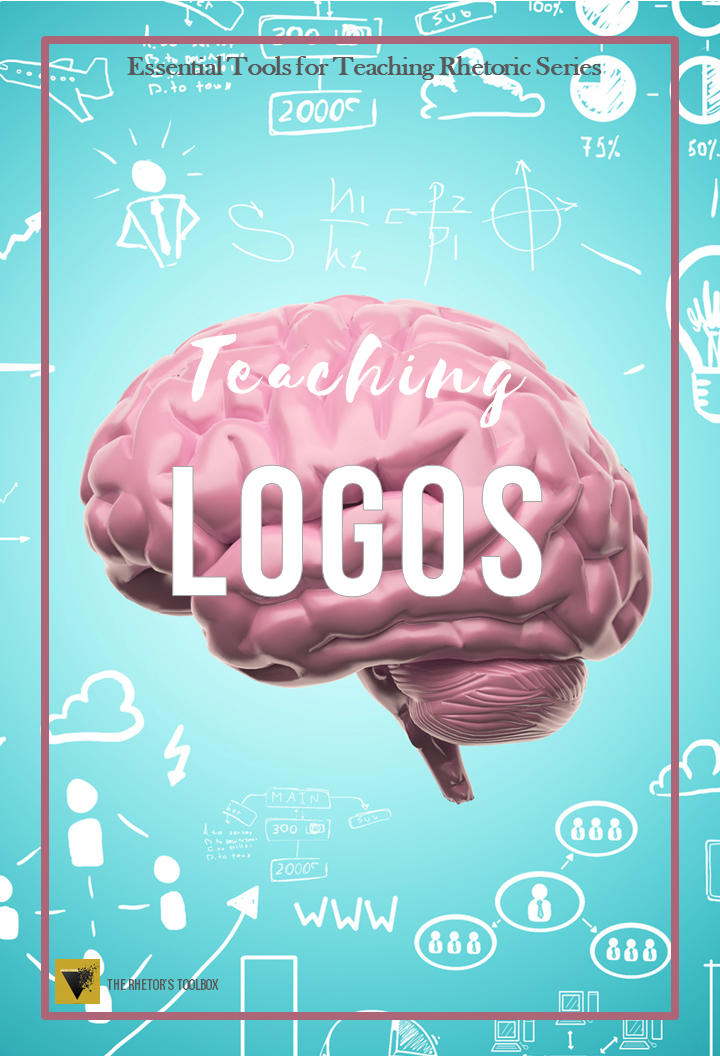What are the essential tools for teaching rhetoric and rhetorical analysis? This blog series will explore one tool each week.
Logos
Logos: it’s “the principle of reason and judgment,” according to the Oxford English Dictionary. Our current understanding of logos in rhetoric is actually linked with Jungian psychology (the same Jungian psychology that gives us our understanding of literary archetypes). Logos is often antithetical to Eros (relationships and love).
What creates logos?
As a rhetorical technique, logos is the logic behind an argument. The power of logos is that hard facts are (at least theoretically) hard to manipulate.
An author might employ strategies such as
- Definitions or explanations of key terms
- Comparison and contrast
- Analogy
- Discussion of cause and effect
- Expert testimony
- Research
- Statistics
- Historical precedent
- Figures of reasoning (devices that appeal to logos or enhance reasoning): enthymeme, syllogism, anythypophora, apophasis, etc.
What are the pitfalls?
The way we explain, justify, and connect data can lead to logical fallacies. Some common logical fallacies:
- Ad hominem.
- Ad populem.
- Slippery slope.
- Hasty generalization.
- Post hoc ergo propter hoc.
- Genetic fallacy.
- Begging the question.
- Circular argument.
- Red herring.
Writing About and With Logos
Logos is the easiest for students to identify and write about, at least superficially.
I like to use editorials from local newspapers as an exercise in analysis. Here’s the process I ask students to apply:
- Choose an editorial.
- Find and highlight the author’s logical strategies.
- For each logical strategy, write a three-sentence analysis. Sentence #1: Identify the strategy and include a quote of 2-3 words. Sentence #2: Explain how the author’s reasoning illuminates or reinforces an idea. Sentence #3: Explain the effect of that particular reasoning on the overall effectiveness of the text.
Note that the analysis focuses more on the effectiveness of the reasoning than the actual data. This is especially important in our “fake news” culture!
The same is true for students who are looking to use logos more effectively in their own writing. They must be intentional about their strategies, aware of potential fallacies, and focused on the quality of their reasoning. One of the best ways to help students do this is to simply have them brainstorm or quick write around each of the logical strategies above. They need to actually write out the definitions and key terms. Then, they need to generate analogies for the key concepts they are trying to explain, and so forth. This is a good exercise to use as a homework assignment; they can share their thinking when they come back to class the next day.
A final note (and a plea): Logos is essential for creating balance in writing. It serves as a bridge between ethos and pathos. However, it can be easily misused. Whatever you do when working with logos in the classroom, please take time to help students recognize the ways in which they can be manipulated through what seems like logical reasoning. Break down tweets, watch commercials, look at print advertisements or news segments or interviews–just take the time to teach them to think for themselves as consumers of media.
If you’d like some teaching resources for working with appeals, check out my Rhetorical Analysis Device Sort Bundle at Teachers Pay Teachers. It has three different sets of engaging examples for students to work with.

Love the ideas! I’m thinking of ways to integrate these strategies into our “article of the week” assignments. I’ve also been collecting tweets and memes for logical fallacy discussion, but I haven’t found an effective way to organize/save this information so that it’ll be easily accessible when I need it.
How did you find so many facts? I enjoy the way you organize everything, as it is actually easy to read.
Overall, I will recommend this article to everybody who is interested in that subject.
That’s interesting! I have been hunting for a place similar to this for a long moment.